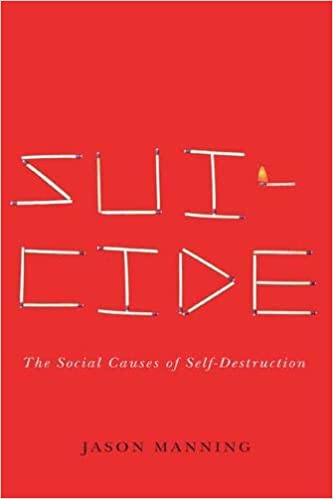Suicide is a fascinating subject, any way you look at it. What prompts someone to take their own life? Hamlet’s “To be or not to be,” the most famous lines in English literature, speak to the central importance of the question, and the subsequent 400 years of Western writing showcase its enduring fascination, but that preoccupation has been overwhelmingly philosophical and psychological. There is another way to look at suicide, however – one that reveals how many various reasons might prompt someone to take their own life. In Suicide: The Social Causes of Self-Destruction, Jason Manning, a professor of sociology at West Virginia University, takes an approach known as “pure sociology,” developed by sociologist Donald Black, that deliberately ignores the psychological and biological factors involved in suicide, focusing exclusively on the social aspects of human behavior that make suicide more or less likely. It’s no way to read Hamlet, to be sure, but it has immense explanatory power all the same, particularly when looking at society from a wider perspective.
I was shocked to discover, for example, how various are the reasons for committing suicide. Depression, despair, melancholy – these were, to my mind, almost synonymous with self-destruction, but Manning’s book elucidates various other reasons people take their own lives: from a deep sense of shame, to revenge themselves on an unfaithful lover, to demonstrate their loyalty to their nation or their god, to protest an injustice, to escape an arranged marriage, or to atone for a terrible misdeed, to name just a few. “A study of European suicide attempters asked them to rate whether various motives had a minor or major influence on their act: about 12 percent chose ‘I wanted to make others pay for the way they treated me’ as a major influence, with a similar percentage picking it as a minor influence.” As a sociologist, Manning’s primary interest is in ascertaining what social factors come into play from a macro perspective:
Suicide is no less social than any other human behavior. It varies across societies and across social locations within societies. It comes in different forms and varieties and is often rooted in some larger category of social life. […] Suicide frequently occurs in the course of conflict, whether in the private conflicts of individuals or large-scale political struggles. It can even act as a form of social control, a moralistic behavior aimed at righting wrongs and punishing offenses. It might be protest or punishment, avoidance or appeal, escape or revenge. As such, it also varies across relationships and situations. It varies from one conflict to another. Most of all, it varies with the structure and motion of social space, and this is our key to explaining it.
Unsurprisingly, sudden drops in status – from a divorce or a job loss, say – are frequent precipitating causes of suicide: “One analysis of US data shows the causal priority of divorce, finding that shifts in the suicide rate occur after shifts in the divorce rate, with a spike in suicide occurring during the first few months after each spike in divorce.” And while social isolation and loneliness are also precipitating causes, the research suggests the sudden loss of status caused by divorce trumps mere bachelorhood: “[…]the effects of being divorced are stronger and more consistent than those of being single, indicating that losing a marriage is more dangerous than merely lacking one.”
Status also plays a role when suicide is used as a weapon or in retaliation for a perceived harm. High-status people, Manning says, rarely take their lives in a dispute with a low-status person, but low-status people – subjects in a tyranny, fathers in custody disputes, women in patriarchal tribal societies, employees angry at their employers – more frequently resort to suicide for a measure of justice or vengeance, and while that may seem like a self-defeating tactic, it is often powerful, given that suicides are more likely to be perceived as victims than aggressors:
Whether placing the blame on mental illness, other people, or ourselves, we attribute responsibility for the violence to factors beyond the perpetrator’s control and are more likely to do so for self-inflicted violence than for violence against acquaintances or strangers. The external displacement of liability is what allows suicide to be a weapon against one’s associates: in the case of social sanctions because other people will hold them responsible, and in the case of psychological sanctions because they will hold themselves responsible.
In one of the book’s more fascinating sections, Manning cites studies from rural Taiwan showing the inter-familial conflicts that arose from arranged marriages: initially, young wives would leave their own families to join the family of their husband, as part of his household, and would begin their new existence at the bottom of the status hierarchy, and subject to the social pressures of their mothers-in-law. Consequently, suicide rates for young wives were among the highest in Taiwan. But as economic development took men off of their ancestral land, and freed them from the control of their parents, young wives displaced their mothers-in-law in status and the suicide rates of young wives dropped precipitously, in tandem with a rise in the suicide rates of mothers-in-law.
Manning’s Suicide is a dry, technical book, and probably not well suited to a lay reader, but would we not be suspicious of an exciting, easy-to-read book on one of life’s grimmest actions? It nonetheless effectively enumerates the various social conditions that impact on suicide rates, and therefore holds out the hope that we may better design our societies to minimize the harm of self-harm.
